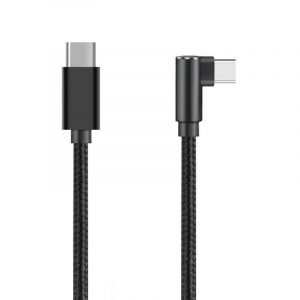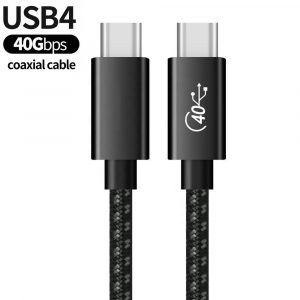USB C Connector Introduction
USB Type-C is a new connector standard that is designed to replace the many different types of connectors that are currently in use. It is reversible, meaning that it can be plugged in either way, and it supports a wide range of data transfer speeds, power delivery, and video output.
The biggest difference between USB C Connector and the Type-A commonly used in notebook computers or Micro-B for Android phones is that USB Type-C supports both positive and negative insertion designs. With the symmetrical design of the upper left and lower right of the 24 pins, half of the pins can operate normally for both forward and reverse insertion. The simplest USB Type-C interface supports USB 2.0 (D+ and D- in Table 1), adds high-speed signal pairs, supports USB 3.1 Gen1 (5Gbps), USB 3.2 Gen2 (10Gbps), USB 34 Gen3 (40Gbps) transmission speed (Tx+- and Rx+- in Table 1). In addition, USB Type-C can increase the power supply wattage from 5V/3A to 20V/5A through the Power Delivery (hereinafter referred to as PD) protocol. At the same time, the version after PD 2.0 has added Alternative Mode (hereinafter referred to as Alt-Mode). Through Alt-Mode, the USB Type-C connector can not only transmit data and power supply but also transmit image or video information. So we can see that more and more devices adopt the USB Type-C interface, which has become a trend. The following article will introduce and share the USB Type-C specification, which is divided into three parts: data, power supply, and video!

USB4 transfer rate up to 40Gbps
1. Transmission bandwidth: USB4 maximum is 40Gbps.
2. Transmission protocol: USB4 encapsulates USB 3.2, DP, and PCIe protocols into data packets through tunneling technology, and sends them at the same time.
3. DP transmission: In addition to configuring the output through DP Alt Mode (alternative mode), USB4 can also extract DP data through USB4 tunneling protocol packets.
4. PCIe transmission: USB4 supports PCIe transmission, and extracts PCIe data through USB4 tunneling protocol packets.
5. TBT3 transmission: USB4 supports TBT3 transmission, which is to extract PCIe and DP data through USB4 tunneling protocol packets.
6. Host to Host: USB 4 supports communication between host and host. The main reason is that USB4 supports the PCIe protocol to support this function.
Note: Tunneling technology can be regarded as a technology that integrates data from different protocols, and the types are distinguished by the data packet header.
In USB4, DisplayPort video, USB 3.2 data, and PCIe data can be transmitted in the same channel, which is the biggest difference between the two. You can look at the picture below for a better understanding. The USB4 channel can be imagined as a lane that can pass various types of vehicles, and the USB data, DP data, and PCIe data can be imagined as different cars. Different cars line up in the same lane and drive in an orderly manner. This is also the principle of USB4 transmitting different types of data on the same channel. USB 3.2, DP, and PCIe data are gathered together, sent out through the same channel, to the other party’s device, and then separated into three different types of data.

The PPS specification meets the demand for fast charging.
In the past, in order to improve the charging speed, people increased the output voltage of the charger to increase the charging wattage of the mobile phone. However, because the step-down circuit in the mobile phone is not efficient in converting the high voltage drop to a low voltage, the mobile phone may generate heat during charging. In order to solve this problem, it is hoped that the step-down circuit in the mobile phone can be removed, so that the output of the charger can be directly connected to the battery terminal of the mobile phone, and the output can be adjusted with the change of the battery voltage, so there is a definition of PPS. PPS is like a PD with standard fixed output, defining four standard voltages: 5V (adjustable 3~5.9V), 9V (adjustable 3~11V), 15V (adjustable 3~16V), 20V (adjustable 3~21V ), within each set of adjustable voltage ranges, the receiver can adjust the power supply with a minimum 20mV voltage step or a 50mA current step according to the current status of the power supply.
If we cooperate with the latest Voltage Scaler developed by the chip manufacturer for different multiples on the device side, the battery can be charged with a high current of 6A, 9A or 12A with a 3A wire. In addition, in version 1.3 of USB Type-C, the Vconn Power Device (VPD) specification is added. The VPD device can not only accept power from the original Vbus but also accept the lowest 3V voltage provided by Vconn. The purpose of the minimum 3V is that a lithium battery is often placed in the mobile device, and the minimum discharge voltage of a single lithium battery is generally set at 3V. In the past, when supplying power through the Vbus of the USB interface, the power supply terminal had to raise the battery voltage to 5V through a boost circuit, and the power receiving terminal would drop the 5V to 3.3V or 1.8V through a step-down chip for other internal chips. Use, resulting in power conversion on both sides and loss of performance.
In the past, when supplying power through the Vbus of the USB interface, the power supply terminal had to raise the battery voltage to 5V through a boost circuit, and the power receiving terminal would drop the 5V to 3.3V or 1.8V through a step-down chip for other internal chips. Use, resulting in power conversion on both sides and loss of performance.
If the voltage of the battery can be effectively supplied directly through Vconn, there is no need to place other power conversion chips on the power supply side or power receiver side, and the overall power conversion efficiency can be greatly improved. As for the E-Marker mentioned above, it is placed in the cable with USB Type-C at both ends, just like the ID card of the cable, which is used to store the data of the cable, including the loadable current (3A or 5A), USB speed (USB 2.0 or USB 3.1), the withstand voltage of the wire, etc., and the power required by the E-Marker is provided by the power supply party from Vconn. E-mark chip popularization

USB Type-C, DisplayPort and PCIE
USB PD is a signal encoded by BMC, while the previous USB is FSK, so there is incompatibility. The USB PD is transmitted on the CC pin. The PD has a VDM (Vendor defined message) function, which defines the device ID. When it reads a device that supports DP or PCIe, the DFP enters the alternate mode. If DFP recognizes that the device is DP, then switch the MUX/Configuration to change the Type-C USB 3.1 signal pin to transmit the DP signal. AUX auxiliary is transmitted by SBU1 and SUB2 of Type-C. HPD is a detection pin, which is similar to CC, so it is shared. While DP has four sets of differential signals of lane0-3, and Type-C has four sets of differential signals of RX/TX1-2, so it is no problem to completely replace them. And in the alternative mode in the DP protocol, the USB signal and the DP signal can be transmitted at the same time, RX/TX1 transmits USB data, and RX/TX2 is replaced by lane0,1 two sets of data transmission, which can support up to 4k at this time. If the DFP recognizes that the device is DP, it switches the MUX/Configuration to change the Type-C USB 3.1 signal pin to transmit PCIe signals. Similarly, PCIe uses RX/TX2 and SBU1, SUB2 to transmit data, and RX/TX1 transmits USB data. The advantage of this is that one interface can use two devices at the same time.

USB Type-C connectors have kinds of advantages. In 2024, a USB-C port will become mandatory for a whole range of electronic devices such as mobile phones, tablets, and headphones. Apple’s MacBook has made people realize the convenience of the USB Type-C interface and let everyone see The development trend of future equipment. It has several features that allow mobile phones to charge faster, has higher data transmission speeds, supports display output, and is more suitable as an output interface for mobile devices. Most importantly, there is a great need for a universal interface at present. while the USB Type C connector provides a reversible insertion interface; the socket can be inserted in any direction for easy and reliable insertion. The connector also needs to support a variety of different protocols and can be backward compatible with adapters HDMI, VGA, DisplayPort, and other connection types from a single Type-C USB port, for performance in electromagnetic interference (EMI) and other harsh environments, and these characteristics may make the Type-C interface truly a unified interface in the future!
Related Products
Wandkey is a MFI certified cable and charger manufacturer, supports OEM/ODM service, printing logo, customized packaging, color, length, mould etc. Welcome to contact us get the quotation and samples for the test.
Any questions feel free to contact us, we would be happy to solve your issues
Related Topics
2022 Latest MFi Authorized Manufacturers list
Differences of Lightning Connector
How to check MFI Certification
How to get MFI Certification for Your Brand?
Why does the MFI Certified Lightning Cable so expensive?
MFI Product Packaging Requirement?
Disassemble MFI Lightning Cable
iPhone 14 Pro may use USB C Charging Port
How do we guarantee the quality?
How to identify counterfeit or uncertified Lightning connector accessories
How to Choose Fast Charging Cable for Your Phone
How do I choose a USB-C cable?
Differences between USB 3.0 3.1 and 3.2
Test on USB C to USB C 3.1 Cable











